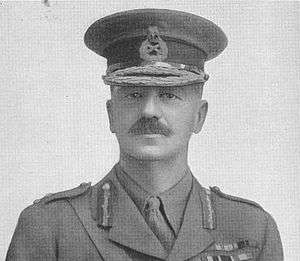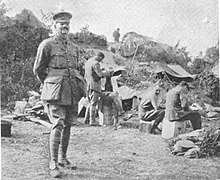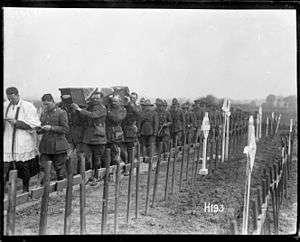Francis Earl Johnston
Brigadier General Francis Earl Johnston, CB (1 October 1871 – 7 August 1917) was a New Zealand-born British Army officer of the First World War, who served in the New Zealand Expeditionary Force (NZEF) at Gallipoli and on the Western Front.
Francis Earl Johnston | |
|---|---|
 Brigadier General Francis Johnston | |
| Born | 1 October 1871 Wellington, New Zealand |
| Died | 7 August 1917 (aged 45) † France |
| Allegiance | United Kingdom |
| Service/ | British Army (1891–14) New Zealand Expeditionary Force (1914–17) |
| Years of service | 1891–1917 |
| Rank | Brigadier General |
| Commands held | New Zealand Rifle Brigade (1917) Sling Camp (1917) 1st Infantry Brigade (1914–16) |
| Battles/wars | Mahdist War Second Boer War First World War
|
| Awards | Companion of the Order of the Bath Mentioned in Despatches (4) |
Born in Wellington, he was educated in England. Joining the British Army, he served with the Prince of Wales’s North Staffordshire Regiment in the Sudan and later in the Second Boer War in South Africa. In New Zealand on secondment to the New Zealand Military Forces when the First World War began, he was posted to the NZEF as commander of the New Zealand Infantry Brigade. He led the brigade through most of the Gallipoli Campaign. Later, on the Western Front, he commanded the 1st Infantry Brigade and, for a brief period, the New Zealand Rifle Brigade. He died as a result of sniper fire on 7 August 1917, one of three New Zealand brigadier generals killed during the war.
Early life
Johnston was born at Wellington in New Zealand on 1 October 1871,[1] the eldest son of merchant Charles John Johnston, who later became the Speaker of the Legislative Council.[2] Sent to England for his education, he attended Stonyhurst College in Lancashire and the Royal Military College, Sandhurst, where he was awarded the Sword of Honour as the best of his intake.
Military career
Johnston was commissioned a second lieutenant in the Prince of Wales’s North Staffordshire Regiment on 5 December 1891,[1] and promoted to lieutenant on 30 November 1895. He saw service in the Sudan with the Dongola Expedition in 1896. Promoted to captain on 13 May 1900, he served from 1900 to 1902 in the Transvaal during the Second Boer War,[2] for which he was mentioned in despatches for good service during the Battle of Boschbult on 31 March 1902.[3]
In 1914, prior to the outbreak of the First World War, Johnston, now with the rank of major, was in New Zealand on leave from his regiment, which was then serving in India. He had been seconded to the New Zealand Military Forces as a temporary lieutenant colonel, and was appointed commander of the Wellington Military District.[4]
First World War
When the New Zealand Expeditionary Force (NZEF) was raised in response to the declaration of war by the New Zealand government, Major General Alexander Godley, the commandant of the New Zealand Military Forces, promoted Johnston to the rank of colonel and put him in command of the New Zealand Infantry Brigade.[4]
Egypt
Shipped to Egypt in October along with the rest of the NZEF, Johnston's brigade underwent intensive training.[5] During this time, he clashed with some of his officers, notably Lieutenant Colonel William Malone, commander of the Wellington Infantry Battalion. Johnston was critical of Malone's training methods, for which Malone had already obtained approval from Godley.[6] The brigade deployed along the Suez Canal late in January 1915 to support Indian troops defending from a rumoured Turkish attack. The brigade assisted the Indian defenders in dealing with a Turkish attack during early February, and suffered its first combat casualties. The attack was repulsed with 3,000 Turkish soldiers killed, wounded or captured, and three weeks of sentry duty ensued before the brigade returned to Cairo, where it had been previously based.[5]
Gallipoli
By this time, the New Zealand and Australian Division, under the command of Godley, was being formed for operations in the Dardanelles, and the brigade formed one of the two infantry brigades (the other was the Australian 4th Brigade).[7] In April, the division embarked for Gallipoli. Landed on the beaches on 25 April, the brigade was under the temporary command of Brigadier General Harold Walker, the chief of staff of the division. Johnston had taken ill on 23 April and missed the landing, returning to his command in early May.[8]

On 2 May, shortly after his return to the brigade, Johnston led it in operations to capture Baby 700, a hill on the slopes overlooking ANZAC Cove. Johnston did not conduct a reconnaissance of the difficult terrain which needed to be traversed by his men prior to the commencement of the attack. As a result, many units had not reached their assigned starting positions by the designated start time of the offensive. The attack, planned by Godley and with ambitious objectives, was beaten off with heavy losses. In Godley's subsequent report on the battle, Johnston was not criticised for his handling of the brigade.[9]
Johnston led the brigade in the Second Battle of Krithia on 8 May, and then the Battle of Chunuk Bair in August. During the latter battle, he displayed poor judgement in coordinating the battalions of the brigade following the initial capture of Chunuk Bair by Malone's Wellington Battalion. Chunuk Bair was lost two days later to the Turks. Johnston, still in poor health, had spells in hospital in September, before leaving Gallipoli altogether in November for Cairo to be with his wife, who later died on 15 December. He was appointed a Companion of the Order of the Bath and mentioned twice in despatches for his conduct during the Gallipoli campaign.[1]
Western Front

Following the withdrawal of Allied forces from Gallipoli to Egypt, the NZEF, now reinforced, had sufficient men to form a stand-alone divisional size formation, the New Zealand Division. Johnston's brigade,[1] now designated the 1st Infantry Brigade,[4] would be one of three infantry brigades in the division. The division was sent to France, where it was involved in operations on the Western Front, and Johnston was again mentioned in despatches for his leadership during the Battle of the Somme.[1]
Still in poor health, in December 1916, Johnston went to England for medical treatment and was diagnosed with neurasthenia. He later took command of the 4th New Zealand Infantry Brigade Reserve Camp, better known as Sling Camp. He returned to the Western Front in late July 1917, this time as commander of the New Zealand Rifle Brigade. Visiting the front lines, he was killed on 7 August 1917 by sniper fire.[1]
Johnston is buried on the edge of Bailleul, in the Bailleul Communal Cemetery Extension. His grave is close to that of Brigadier General Charles Henry Brown, Johnston's successor as commander of the 1st Infantry Brigade. Brown had been killed just a few weeks previously.[10] He was survived by his second wife, Alice Seaton, who he had married several months before his death.[11]
Notes
- McGibbon 2000, p. 260.
- "A General Killed: Brigadier Johnston, C.B." New Zealand Herald. 10 August 1917.
- "No. 27455". The London Gazette. 18 July 1902. p. 4595.
- Pugsley 1984, pp. 50–51.
- Waite 1919, pp. 47–59.
- Stowers 2015, pp. 88–89.
- Waite 1919, pp. 59–60.
- Pugsley 1984, p. 104.
- Pugsley 1984, pp. 182–183.
- McGibbon 2001, p. 37.
- Stowers 2015, pp. 87–88.
References
- McGibbon, Ian, ed. (2000). The Oxford Companion to New Zealand Military History. Auckland, New Zealand: Oxford University Press. ISBN 0-19-558376-0.CS1 maint: ref=harv (link)
- McGibbon, Ian (2001). New Zealand Battlefields and Memorials of the Western Front. Auckland, New Zealand: Oxford University Press. ISBN 0-19-558444-9.CS1 maint: ref=harv (link)
- Pugsley, Christopher (1984). Gallipoli: The New Zealand Story. Auckland, New Zealand: Hodder & Stoughton. ISBN 0-340-338776.CS1 maint: ref=harv (link)
- Stowers, Richard (2015). Heroes of Gallipoli. Christchurch, New Zealand: John Douglas Publishing. ISBN 978-0-9941059-5-0.CS1 maint: ref=harv (link)
- Waite, Fred (1919). The New Zealanders at Gallipoli. Official History of New Zealand's Effort in the Great War. Auckland, New Zealand: Whitcombe & Tombs Limited. OCLC 6268942.CS1 maint: ref=harv (link)